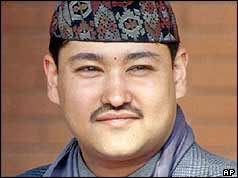On this day in 2001 Prince Dipendra, the Crown Prince of Nepal, killed most of his family before turning the gun on himself at a banquet being held in the Narayanhity Royal Palace in the Nepali capital of Kathmandu. Despite his attempted suicide, Prince Dipendra lingered on life support for three days, during which time he was the de facto King of Nepal. He was eventually succeeded by his uncle Gyanendra.
 Slain by Prince Dipendra in the massacre were his father King Birendra, mother Queen Aishwarya, brother Prince Nirajan, sister Princess Shruti, former Prince Dhirendra (a younger brother who had renounced his title), the King's cousin Princess Jayanti, aunts Princess Shanti and Princess Sharada, and Princess Sharada's husband Kumar Khadga as well as an unspecified number of servants. Wounded were another aunt Princess Shova, Princess Shruti's husband Kumar Gorakh, Princess (now Queen) Komal, another of King Birendra's cousins Ketaki Chester, and Gyanendra's tearaway son and heir Prince Paras.
Slain by Prince Dipendra in the massacre were his father King Birendra, mother Queen Aishwarya, brother Prince Nirajan, sister Princess Shruti, former Prince Dhirendra (a younger brother who had renounced his title), the King's cousin Princess Jayanti, aunts Princess Shanti and Princess Sharada, and Princess Sharada's husband Kumar Khadga as well as an unspecified number of servants. Wounded were another aunt Princess Shova, Princess Shruti's husband Kumar Gorakh, Princess (now Queen) Komal, another of King Birendra's cousins Ketaki Chester, and Gyanendra's tearaway son and heir Prince Paras.
The whys and the wherefores of the massacre may never be accounted for; among the few survivors there are no tattle-tales and a book entitled Raktakunda (recently published in Nepal and purporting to be an eyewitness account) is said to be riddled with inconsistencies and has been labelled a 'fairytale'. The official line, though, is that Prince Dipendra had been forbidden to marry the woman he wanted, Devyani Rana; the conspiracies say that Gyanendra had engineered the massacre to restore himself to the throne*, that Dipendra hadn't even been the shooter, that the reason Gyanendra was spared is that he was conveniently in another part of the kingdom at the time, and on and on...
The whys and the wherefores of the massacre may never be accounted for; among the few survivors there are no tattle-tales and a book entitled Raktakunda (recently published in Nepal and purporting to be an eyewitness account) is said to be riddled with inconsistencies and has been labelled a 'fairytale'. The official line, though, is that Prince Dipendra had been forbidden to marry the woman he wanted, Devyani Rana; the conspiracies say that Gyanendra had engineered the massacre to restore himself to the throne*, that Dipendra hadn't even been the shooter, that the reason Gyanendra was spared is that he was conveniently in another part of the kingdom at the time, and on and on...
Only the results, as senseless as they are, seem to make any sense; anyway, what's done is done, and the reasons why scarcely matter any more. More than just a family died that day, though, but an entire royal house; the Shah Dynasty was abolished in May 2008, four days shy of the seventh anniversary of the massacre, having reigned since September 1768 and unable to regain the people's confidence following the tragedy that befell them.
The entire story is told in Amy Willesee and Mark Whittaker's excellent book Love and Death in Kathmandu: A Strange Tale of Royal Murder. Part history tome, part journalistic expose, part travelogue, the book follows the Australian marrieds as they travel through the famously secretive mountain kingdom in search of answers. Along the way they encounter Chinese Maoists bent on destroying the people's love of their King by hook or by crook, a history of a royal family drenched in blood from way back, and strangely eerie astrological predictions of the disaster to come in a land which takes it's astrology very seriously, as well as a cast of characters rendered unforgettable merely by the fact that they actually exist, including a young woman who was briefly the Hindu goddess Kumari, despite being a Buddhist herself.
*Gyanendra had served as King before, from November 1950 to January 1951, while his grandfather King Tribhuvan was briefly in exile, and was said to be unhappy at having to renounce his position after Tribhuvan's return.
*
share on: facebook



2 comments:
holy moses - what's 'pop culture' about this???
It was the subject of at least one BBC documentary and several novels mention it as well.
Royalty are the ultimate in pop. Their pictures are on the money, in the post office, on the stamps.
Post a Comment